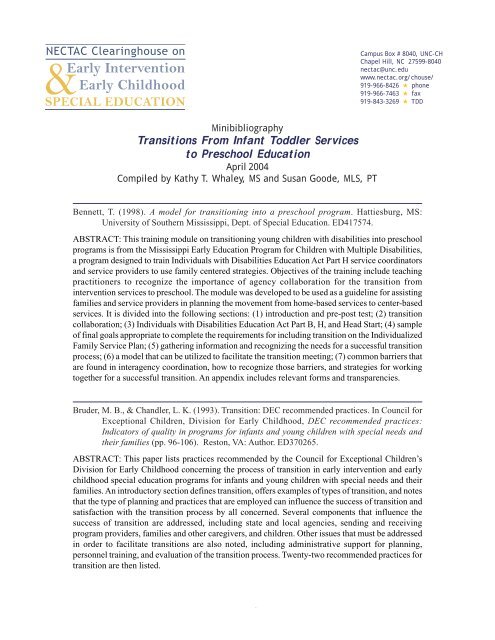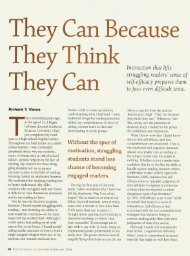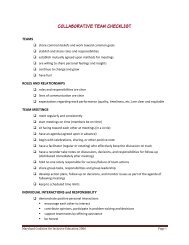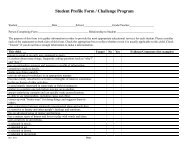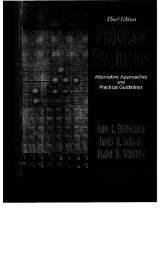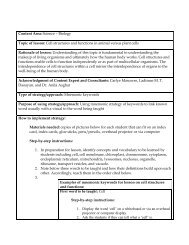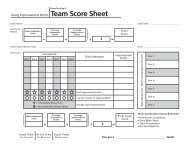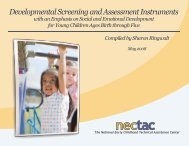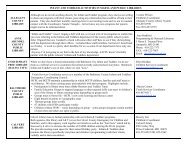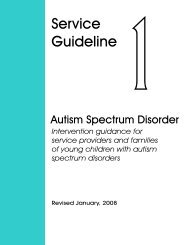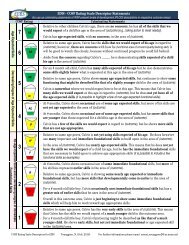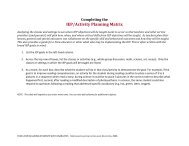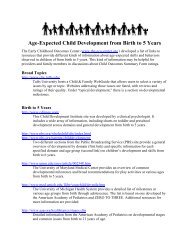Early Intervention Early Childhood - CTE - Online Learning ...
Early Intervention Early Childhood - CTE - Online Learning ...
Early Intervention Early Childhood - CTE - Online Learning ...
- No tags were found...
You also want an ePaper? Increase the reach of your titles
YUMPU automatically turns print PDFs into web optimized ePapers that Google loves.
NECTAC Clearinghouse on&<strong>Early</strong> <strong>Intervention</strong><strong>Early</strong> <strong>Childhood</strong>SPECIAL EDUCATIONCampus Box # 8040, UNC-CHChapel Hill, NC 27599-8040nectac@unc.eduwww.nectac.org/chouse/919-966-8426 phone919-966-7463 fax919-843-3269 TDDMinibibliographyTransitions From Infant Toddler Servicesto Preschool EducationApril 2004Compiled by Kathy T. Whaley, MS and Susan Goode, MLS, PTBennett, T. (1998). A model for transitioning into a preschool program. Hattiesburg, MS:University of Southern Mississippi, Dept. of Special Education. ED417574.ABSTRACT: This training module on transitioning young children with disabilities into preschoolprograms is from the Mississippi <strong>Early</strong> Education Program for Children with Multiple Disabilities,a program designed to train Individuals with Disabilities Education Act Part H service coordinatorsand service providers to use family centered strategies. Objectives of the training include teachingpractitioners to recognize the importance of agency collaboration for the transition fromintervention services to preschool. The module was developed to be used as a guideline for assistingfamilies and service providers in planning the movement from home-based services to center-basedservices. It is divided into the following sections: (1) introduction and pre-post test; (2) transitioncollaboration; (3) Individuals with Disabilities Education Act Part B, H, and Head Start; (4) sampleof final goals appropriate to complete the requirements for including transition on the IndividualizedFamily Service Plan; (5) gathering information and recognizing the needs for a successful transitionprocess; (6) a model that can be utilized to facilitate the transition meeting; (7) common barriers thatare found in interagency coordination, how to recognize those barriers, and strategies for workingtogether for a successful transition. An appendix includes relevant forms and transparencies.Bruder, M. B., & Chandler, L. K. (1993). Transition: DEC recommended practices. In Council forExceptional Children, Division for <strong>Early</strong> <strong>Childhood</strong>, DEC recommended practices:Indicators of quality in programs for infants and young children with special needs andtheir families (pp. 96-106). Reston, VA: Author. ED370265.ABSTRACT: This paper lists practices recommended by the Council for Exceptional Children’sDivision for <strong>Early</strong> <strong>Childhood</strong> concerning the process of transition in early intervention and earlychildhood special education programs for infants and young children with special needs and theirfamilies. An introductory section defines transition, offers examples of types of transition, and notesthat the type of planning and practices that are employed can influence the success of transition andsatisfaction with the transition process by all concerned. Several components that influence thesuccess of transition are addressed, including state and local agencies, sending and receivingprogram providers, families and other caregivers, and children. Other issues that must be addressedin order to facilitate transitions are also noted, including administrative support for planning,personnel training, and evaluation of the transition process. Twenty-two recommended practices fortransition are then listed.page 1
Bruns, D. A., & Fowler, S. A. (2001). Transition is more than a change in services: The need fora multicultural perspective. Champaign, IL: <strong>Early</strong> <strong>Childhood</strong> Research Institute on Culturallyand Linguistically Appropriate Services, University of Illinois at Urbana-Champaign.Retrieved on September 16, 2003 from http://clas.uiuc.edu/techreport/tech4.htmlABSTRACT: The transition from early intervention services (EI) to preschool services (ECSE)presents many challenges to children, families, service providers, and programs. The needs andpreferences of families from culturally and linguistically diverse groups may pose additionalchallenges. The DEC Recommended Practices and NAEYC guidelines offer criteria to evaluatecurrently used transition practices in EI/ECSE and early childhood education (ECE). Within thiscontext, the preparation, implementation and follow-up, and evaluation of transition practices forchildren, families, and service providers and programs is considered. Conclusions are offeredregarding current transition practices and their congruence with recommended practices. Finally,five factors, the 5C’s (community context, collaboration, communication, family concerns, andcontinuity), are presented as additional principles to guide the development and utilization oftransition practices for families from culturally and linguistically diverse groups.Byrd, M. R., Stephens, P., Dyk, L., Perry, E., & Rous, B. (1991). Sequenced transition toeducation in the public schools: Project STEPS replication manual (Rev. ed.).http://www.ihdi.uky.edu/stepsweb/resources.htmlABSTRACT: This manual describes the process involved in establishing a community wide systemfor transition of young children using the STEPS model. The manual includes an overview of transitionand interagency collaboration and a description of how to develop and implement a transitionsystem that addresses administration, staff involvement, family involvement, and child preparationfor transition.Donegan, M., Fink, D. B., Fowler, S. A., & Wischnowski, M. W. (1994). Entering a new preschool:How service providers and families can ease the transitions of children turning three whohave special needs. Champaign, IL: FACTS/LRE University of Illinois at Urbana-Champaign. Retrieved March 25, 2004 from http://facts.crc.uiuc.edu/facts2/facts2.htmlABSTRACT: This booklet discusses some of the issues children and families may experience whenchildren enter group settings at age three. Strategies related to transition planning, preparingchildren for the change, and working with families and staff from sending and receiving programsbefore and after transitions are described. To illustrate the recommended strategies, a fictionalizedaccount of one child’s experience with transition is included. Additional resources including a list ofbooks to prepare children for transition are provided.Fink, D., Borgia, E., & Fowler, S. A. (1993). Interagency agreements: Improving the transitionprocess for young children with special needs and their families. Champaign, IL: FACTS/LRE University of Illinois at Urbana-Champaign. Retrieved March 25, 2004 fromhttp://facts.crc.uiuc.edu/facts1/facts1.htmlABSTRACT: This booklet suggests that an interagency agreement on transition between earlyintervention providers and the public schools in a community can be an “invisible brace” supportingfamilies and staff as they prepare for each child’s move at age three from one service system toanother. It includes two “family transition stories,” reader-friendly explanations of Part H, Part B,and “least restrictive environment,” a list of the components of interagency agreements, one actualagreement and one “model” agreement.page 2
Fowler, S. A., Donegan, M., Lueke, B., Hadden, S., & Phillips, B. (2000). Evaluating communitycollaboration in writing interagency agreements on the age 3 transition. ExceptionalChildren, 67(1), 35-50.ABSTRACT: Representatives from 34 local interagency coordinating councils were interviewedabout interagency agreements for the legally required transition from the infant/toddler to preschoolservice delivery system at age 3. Results indicated that most communities included the majority oflegal transition requirements in their agreements. Policy issues identified included ensuringcontinuity of services and interpretations of regulations.Fowler, S. A., Hains, A. H., & Rosenkotter, S. E. (1990). The transition between early interventionservices and preschool services: Administrative and policy issues. Topics in <strong>Early</strong><strong>Childhood</strong> Education, 9(4), 55-65.ABSTRACT: The researchers of this article suggest that it is important for administrators ofcommunity programs to keep service providers informed of eligibility criteria for preschoolservices. This information is important for early intervention service providers because they need toknow what services are available and can recommend the best program for the children needing totransition to a program. This also reduces tension between service providers that may arise when asending community agency may have unrealistic or uniformed expectations of a receiving agency.The authors also suggest that administrators initiate interagency coordination. It is important thatprograms collaborate to identify funding agencies, develop guidelines for the exchange of childrecords, and so that service providers are made aware of other local programs and services availableto the families of their students.Hadden, S., Fowler, S. A., Fink, D., & Wischnowski, M. W. (1995). Writing an interagencyagreement on transition: A practical guide. Champaign, IL: FACTS/LRE University ofIllinois at Urbana-Champaign. Retrieved March 25, 2004from http://facts.crc.uiuc.edu/facts5/facts5.htmlABSTRACT: This manual provides detailed, step-by-step information on writing an interagencyagreement around the age three transition. Information presented is based upon the authors’experiences assisting over 40 communities to write agreements. Worksheets which pose guidingquestions are included to help facilitate the process of writing an agreement. Three sampleagreements are presented along with excerpts which illustrate specific topical areas.Hadden, S., & Fowler, S. A. (2000). Interagency agreements: A proactive tool for improving thetransition from early intervention to preschool special education services. YoungExceptional Children, 3(4), 2-7.ABSTRACT: This article offers guidelines to help agencies develop and write interagencyagreements covering the transition of young children with disabilities from early interventionprograms to public special education services. Guidelines cover the content and process of writingan agreement and finalizing, signing, and monitoring the agreement. Sample worksheets areincluded.Hadden, S., & Fowler, S. A. (1997). Preschool: A new beginning for children and parents. TeachingExceptional Children, 30(1), 36-39.ABSTRACT: Discusses the importance of communication between preschool providers and parentsof children with disabilities who are transitioning from early intervention programs to preschoolprograms. Communication needs before, during, and after the transition are addressed. A samplequestionnaire for families of new students and a communication schedule are provided.page 3
Hanson, M. J., Beckman, P. J., Horn, E., Marquart, J., Sandall, S. R., Greig, D., & Brennan, E.(2000). Entering preschool: Family and professional experiences in this transition process.Journal of <strong>Early</strong> <strong>Intervention</strong>, 23(4), 279-93.ABSTRACT: A study investigated the experiences of 22 families of children (age 3) with disabilitiesas they entered, participated in, and exited the transition process. The shift in service deliverymodels was often problematic, families were given a limited choice of preschool programs, and fewprograms offered inclusive service models.Hanson, M. J. (1999). <strong>Early</strong> transitions for children and families: Transitions from infant/toddlerservices to preschool education. Reston, VA: ERIC Clearinghouse on Disabilities and GiftedEducation, Council for Exceptional Children. Retrieved March 25, 2004 fromhttp://ericec.org/digests/e581.htmlABSTRACT: This Digest summarizes what is known about the successful transition of childrenwith disabilities from infant/toddler services to preschool education. The ideal transition process isdefined and characteristics of an ideal process such as meeting individual needs and providinguninterrupted services are listed. Also noted are issues in the transition process such as differences ineligibility processes and philosophical shifts in intervention models. The paper focuses on fivestrategies which have been demonstrated to be effective: (1) interagency coordination; (2) preparation,information exchange, and training among sending programs, receiving programs, and families;(3) family support; (4) child preparation; and (5) staff training and collaboration. Some findingsof the <strong>Early</strong> <strong>Childhood</strong> Research Institute on Inclusion are noted concerning families’ and professionals’experiences and perceptions during the transition process, their expectations and concerns,and factors that affected or influenced the transition process and outcome.Lazzari, A. M. (1991). The transition sourcebook: A practical guide for early interventionprograms. Tucson, AZ: Communication Skill Builders.ABSTRACT: The purpose of this book is to provide professionals and parents with practical guidelinesfor effecting positive transitions for infants, toddlers, preschool children, and their families.The text is supplemented with numerous forms, checklists, timelines, and charts that programs canuse in developing or modifying transition strategies and parents can use as they plan their child’stransitions. The appendices provide training suggestions and materials for use at the preservice orinservice levels or with parents. It is anticipated that program staff will modify these materials tomeet the unique needs for transition in various settings, as mandated by state and local regulationsand practices.Malveaux, J. A., Welker, P. L., & Norlin, J. W. (2003). Transitioning from Part C to Part B:Practical guidance and legal issues. Horsham, PA: LRP Publications.ABSTRACT: A host of issues can arise when transitioning a child from Part C to Part B. Sometimesthe problems associated with this transition lead to legal resolution, either at due process or in thecourts. This is especially true when parties involved disagree on placement, service delivery andindividualized education programs. Other issues such as eligibility, and parental involvement andconsent also have led to due process hearings. This document discusses the range of issuesinvolving Part C to Part B transitioning that often lead to due process, including family involvement,Part C/Part B collaboration, IFSP and IEP differences and service delivery. It includes summaries oflegal decisions involving those topics, as well as articles describing transition issues. All judicialand administrative decisions that have been published in LRP Publications’ Individuals withDisabilities Education Law Report and <strong>Early</strong> <strong>Childhood</strong> Law and Policy Reporter are cited to thosepublications.page 4
Minor, L. (1997). Effective practices in early intervention: Planning transitions to preschool. InChen, D. (Ed.). Effective practice in early intervention: Infants whose multiple disabilitiesinclude both vision & hearing loss. Northridge, CA: California State University. RetrievedMarch 25, 2004 from http://www.tr.wou.edu/dblink/chenminor.htmABSTRACT: A transition is a change from one service or program to another. Families of infantsand toddlers with dual sensory impairments (vision and hearing), including multiple disabilities, arelikely to experience more transitions than families of other children. One major transition families oftoddlers with disabilities face is moving from home or center-based to preschool programs. Thischange involves not only different settings such as regular or special preschool programs, but alsochanges from the Individual Family Service Plan (IFSP) to the Individualized Education Plan (IEP),and from family focused to child focused services. This chapter discusses important considerationswhen transitioning toddlers with dual sensory impairments and other multiple disabilities from homeand center-based infant programs to preschool programs.Rosenkoetter, S. E., Hains, A. H., & Fowler, S. A. (1994). Bridging early services for children withspecial needs and their families: A practical guide for transition planning. Baltimore, MD:Paul H. Brooks Publishing Co. ED369239ABSTRACT: This volume presents a comprehensive plan for transition of children with specialneeds and their families between infant or early intervention services and preschool services, andbetween preschool services and kindergarten. It aims to help in bridging these services to minimizethe stress and increase the promise of early childhood transitions. The chapters discuss: (1) a rationalefor bridge-building; (2) federal and state laws and regulations and current national trends thatguide transition planning; (3) elements of effective transitions and a model useful for different kindsof transitions; (4) interagency activity needed for effective transition planning, such as definingroles, responsibilities, and timelines; (5) intra-agency coordination; (6) ways for parents andprofessionals to collaborate; (7) practical strategies for incorporating the preferences and concernsof diverse families; (8) concepts of developmental and instructional continuity for children; (9)actions recommended for sending programs; (10) actions recommended for receiving programs;(11) guidance for interagency planning to serve young children with complex health care needs incommunity settings; (12) ways to evaluate transitions; (13) the larger context of transitions amongearly childhood services; and (14) future directions for transition planning, with suggested roles forparents, service providers, administrators, policy-makers, and researchers. Appendices provide a listof national projects focused on transition, sample interagency agreements, sample timelines,materials for establishing a toddler transition play group, guidelines for developing a communityresource directory, and sample evaluation tools.Rosenkoetter, S. E., Whaley, K. T., Hains, A. H., & Pierce, L. (2001). The evolution of transitionpolicy for young children with special needs and their families: Past, present, and future.Topics in <strong>Early</strong> <strong>Childhood</strong> Special Education, 21(1), 3-15.ABSTRACT: This article describes the types of early childhood special education transitions thathave or have not received federal or state policy development. It is suggested that bi-directionalinfluences on transition policy have connected the decisions of policymakers at multiple levels withthe actions and advocacy of family and practitioner stakeholders. Current challenges in effectiveearly childhood transitions are identified.page 5
Rous, B. (n.d.). <strong>Early</strong> childhood transition resources and practices: Annotated bibliography.Lexington, KY: University of Kentucky, Interdisciplinary Human Development Institute,National Center for Collaborative Planning. Retrieved March 25, 2004 fromhttp://www.ihdi.uky.edu/stepsweb/Transition - Bibliography.pdfABSTRACT: This annotated bibliography provides information on publications related to researchand practice in the area of early childhood transition for young children from birth to age eight.Information is presented on the following topics: transition overview, program design, crossprogram/agency activities, families, policies and supports, and evaluating the process. Includes amatrix that summarizes the information presented and topics covered within the document.Rous, B. (1997). Project STEPS: Assessment of current transition practices and transition systemdevelopment plan. Lexington, KY: Child Development Centers of the Bluegrass, Inc.ED423629.ABSTRACT: This set of forms is part of Project STEPS (Sequenced Transition to Education in thePublic Schools). They are intended to assist communities develop and use a formalized process forassessing the current status of transition within their community and for interagency planningrelated to the development of a community-wide transition team. The forms are to be completed bya community team during a three-day intensive inservice training session. The inservice processinvolves three steps: (1) completion of the team vision and scope statement; (2) assessment of thecurrent status (whether formalized policies and procedures are in place, partially in place, or not inplace); and (3) development of the transition system plan, including choice of activities forimplementation, timelines for completion, and assignment of responsible individuals. Theassessment process involves evaluation of current administrative structure, the InteragencyCommittee, staff development, family involvement, and child transition.Rous, B., Hemmeter, M. L., & Schuster, J. (1994). Sequenced transition to education in the publicschools: A systems approach to transition planning. Topics in <strong>Early</strong> <strong>Childhood</strong> SpecialEducation, 14(3), 374-393.ABSTRACT: This article describes a model project for promoting interagency collaboration at stateand local levels to facilitate transitions of young special needs children and their families frominfant/toddler programs to preschool programs. Project Sequenced Transition to Education in thePublic Schools (STEPS) has four major components: interagency involvement, staff involvement,family involvement, and child preparation.Rous, B., Hemmeter, M. L., & Schuster, J. (1999). Evaluating the impact of the STEPS model ondevelopment of community-wide transition systems. Journal of <strong>Early</strong> <strong>Intervention</strong>, 22(1),38-50.ABSTRACT: A study investigated effects of training related to using the Sequenced Transition toEducation in the Public Schools model (STEPS) on the development of community-wide transitionsystems. Seven teams composed of public schools, Head Start, and early intervention representativeswere trained. Change occurred as a result of the training.page 6
Sarathy, P. (2003). “Together we succeed”: Building a better system for transitioningpreschoolers with disabilities. Horsham, PA: LRP Publications.ABSTRACT: This guide offers creative ideas and strategies for developing and implementing abest-practice system to achieve smooth transitions from one service delivery model to another foryoung children with special needs and their families. It focuses on three major transitions for thechild and the family during the early childhood years including: the transition from early intervention(EI) services to preschool special education services, transitions while receiving preschoolspecial education services, and the transition from preschool to school-age services. The objectivesof the guide are to: (1) provide an overview of the differences between EI services and preschoolservices, and between preschool services and school-age services; (2) outline requirements of thelaw to achieve smooth transitions for young children with disabilities and their families; (3) discusstransition challenges and issues, and how transition impacts different stakeholders involved; (4)present systemic, research-based strategies for overcoming challenges and promoting effectivetransition practices; (5) present Together We Succeed (TWS), a multi-pronged systemic approach totransition planning; (6) provide a variety of activities to implement TWS, with a practical step-by -step approach on how to execute the activities and case examples to supplement and reinforce theactivities; (7) provide flowcharts, checklists and surveys associated with the implementation of theTWS activities, which can be copied, modified and adapted to suit local needs; (8) identifyevaluation procedures to monitor the success of the transition process system.Swedeen, B. (2001). Birth to three transition: One family’s story. Young Exceptional Children,4(2), 12-14.ABSTRACT: A mother discusses her family’s experience in transitioning her daughter from earlyintervention services to an early childhood program. Helpful strategies that the early childhood staffused are identified and include introducing families to teachers during the transition process andallowing parents to visit the program before sending their child.U.S Head Start Bureau. (2000). Effective transition practices: Facilitating continuity. Trainingguides for the Head Start learning community. Washington, DC: U.S. Dept. of Healthand Human Services, Administration for Children and Families, Administration onChildren, Youth, and Families, Head Start Bureau. Retrieved March 25, 2004 fromhttp://www.headstartinfo.org/publications/effective_transitions/index.htmABSTRACT: This foundation guide familiarizes all staff with the elements and requirements ofeffective transition; increases staff and parent skills that support children and families preparing fortransition and helps staff and families identify specific practices to support transition.U.S. Head Start Bureau & Aspen Systems Corporation. (1999). Infant and toddler transitions.Training guides for the Head Start learning community. Washington, DC: U.S. Dept. ofHealth and Human Services, Administration for Children and Families, Administrationon Children, Youth, and Families, Head Start Bureau. Retrieved March 25, 2004from http://www.headstartinfo.org/publications/infant-toddler_transitions/index.htmABSTRACT: <strong>Early</strong> Head Start and Head Start families, managers, and staff are aided in developingskills and practices that support the healthy development and transitions of infants and toddlers andtheir families. Through this technical training guide, staff and families learn to examine infant andtoddler transitions from a developmental perspective; individualize routines and practices to supporteach child’s needs; plan for transitions that ensure consistency and continuity; and implement measuresfor evaluating the quality and effectiveness of transitions.page 7
Wischnowski, M. W., Fowler, S. A., & McCollum, J. A. (2000). Supports and barriers to writing aninteragency agreement on the preschool transition. Journal of <strong>Early</strong> <strong>Intervention</strong>, 23(4),294-307.ABSTRACT: Participants from four teams attempting to write an interagency agreement on thetransition of children with disabilities from early intervention programs to early childhood specialeducation were interviewed at three points in time, spanning 5 months. Results indicate that writingan interagency agreement was a complex, multidimensional, and sequential process.nationalearly childhoodTA CenterTo search the ERIC databases or access the references herein,see http://www.nectac.org/chouse/Copyright © 2004This minibiliography is produced and distributed by the NECTAC Clearinghouse on <strong>Early</strong><strong>Intervention</strong> and <strong>Early</strong> <strong>Childhood</strong> Special Education, a component of the National <strong>Early</strong><strong>Childhood</strong> Technical Assistance Center (NECTAC), pursuant to contract ED-01-CO-0112from the Office of Special Education Programs, U.S. Department of Education (ED).Contractors undertaking projects under government sponsorship are encouraged toexpress their judgment in professional and technical matters. Opinions expresseddo not necessarily represent the Department of Education’s position or policy.page 8


